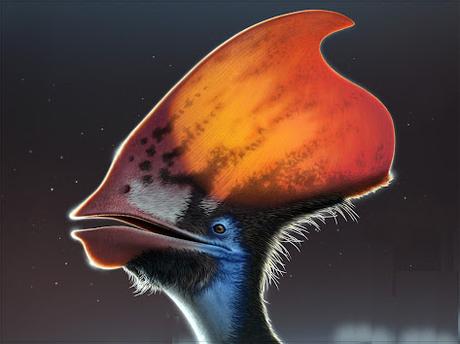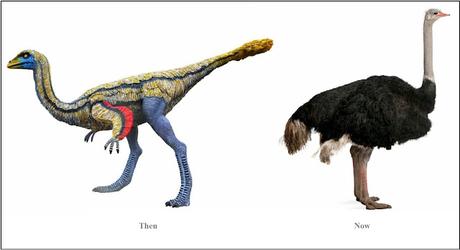
Tupandactylus imperator
But why would dinosaurs develop feathers at all? Maria McNamara at University College Cork in Ireland and her colleagues found preserved feathers on a fossilised partial pterosaur skull excavated in Brazil. Specimens of this particular species, Tupandactylus imperator, have prominent crests on their heads; the feathers on this skull were found on either side of the crest.The researchers found two types of feathers: whisker-like monofilaments and more complex branching feathers. When examined under a microscope, each type of feather contained different sorts of melanosomes, tiny pieces of cells that synthesise and store the pigment melanin.“The specific colours don’t really matter from an evolutionary sense; what matters is that they have these different colours,” says McNamara. “It probably means that the ability to impart color is something that’s really ancient and that’s tied up in the whole way that feathers were evolved.” Because both pterosaurs and some dinosaurs had multicoloured feathers, the feathers were probably passed down from a common ancestor in the early Triassic period, around 250 million years ago, she says.These illustrations of an Ornithomimus and an Ostrich show the link between past and present:

Michael Benton states that if the feathers were all the same colour, they might have been used only for insulation, but the finding of multiple colours indicates that they were probably used for signaling as well, perhaps for camouflage or attracting mates.
While I was finding all this out I started to wonder whether it would make me feel safer being chased by a scaly or a fluffy colourful dinosaur. I haven’t decided yet.
The Coloration of Feathers
For glory and brilliance the colours of feathers
are unsurpassed. Yet the pigments which produce
those shades are few. Some (called subjective
or optical colours) are illusions formed
by the quills' pattern and its achromatic,
horny surface. Is other creatures' vision
of them different, paler or darker than ours?
Melanin, from blood-plasma or haemoglobin,
makes black, brown and grey; turacin, which fades
when wet, will flush to purple. Darwin wrote
that natives of the Amazonian region
feed fatty fish to green parrots so the lipochromes
will streak them red and yellow (the sacred
tints of royal Inca's feather garments).
Prismatic and metallic tones: blue, gold
and glossy black, are the structural colours.
Only the white lacks underlying pigment.
The evolution of vivid plumage began with
the struggle to win a mate. But the drab hues
of survivors disturb: such complex beauty
unnecessary after that triumph. Ruth Fainlight (1931 - )
Thanks for reading,
Terry Q Email ThisBlogThis!Share to TwitterShare to Facebook
